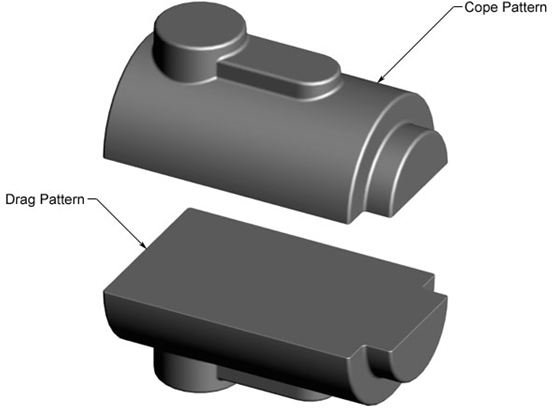Sand Casting Techniques – Types of Patterns
Introduction
Casting is a unique manufacturing technique which has the advantages of being economical as well as versatile. Casted components have the advantage of being strong even if they are of intricate shapes, which is difficult if not impossible to achieve with other manufacturing techniques. Patterns are the key in making casting and in this article we will learn about the types of patterns used in casting.
What is a Pattern?
A pattern is simply the duplicate of the component which has to be manufactured by the casting process. The need to prepare such a pattern is because casting basically involves pouring molten metal in a hollow space which could be cavity in the sand, etc. So how do we make the cavity which is similar to the part to be manufactured? The pattern which is used for this purpose and if you see the last sentence carefully, I used the word “similar” and not “same.”
The reason for this is that though the pattern is of the same shape like the part to be made, it is not exactly the same in size. The reason for this is that there also has to be a provision for metal shrinkage when it converts from liquid to solid state. Hence the cavity needs to be a little bigger than the actual part required. Then there could be some allowances for machining, finishing, and so forth.
The exact size of the pattern is decided by the pattern maker who is a technician skilled in the art of making patterns. The materials used for making pattern are normally wood, metal or plastics, and the exact material used varies depending on the specific situation.
Types of Patterns
Patterns can be of different types depending on the shape and size of the part to be manufactured. Given below are some of the commonly used pattern types.
-
A solid pattern is the most simple of all and is used to make simple shapes. As the name itself suggests, a solid pattern is a single solid piece without any subparts or joints.
-
Shapes which are more intricate are manufactured using patterns which are made out of 2 or more pieces. These pieces are aligned together with the help of dowel pins, and such patterns are known as split patterns
-
Sometimes it is convenient to produce multiple parts in one go and a single pattern is used to make the cavity for all the part spaces. There are runners between these pieces, which are also known as gates. Hence these patterns go by the name of gated patterns.
-
In several cases it could be economical to save the money and efforts of making the full pattern because of symmetry. The cavity in such a case could be made by sweeping the pattern (which is a part of the full shape) around a central axis, hence these are known as sweeping patterns.
The above list is not exhaustive and there are several other types of patterns as well such as loose piece patterns, follow board and odd-shaped patterns which are used for different situations. Yet the description above should have given a broad idea to the reader about the patterns, their types and usefulness in the casting manufacturing process.
The two images show a solid pattern and a split pattern (both having same shape)

Image Credits
CustomPartNet.com
